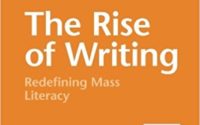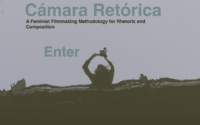Representation, Resistance, and Rhetoric: Bananas Catalyze Campus Activism
Examining food and agricultural systems cultivates nuanced understandings of rhetoric, campus activism, and cultural and scientific meanings of food. At Iowa State University, the banana has provoked discussions regarding biotechnology—prompting debates with competing narratives about food and agricultural systems. Because of its status as a genetically modified food (developed in campus food sciences and human nutrition labs and purportedly able to address hunger and malnutrition in the Global South), this particular biotech banana prompted reactions from sustainable agriculture students with social and ecological justice concerns. For those working at land grant universities conducting food and agriculture research especially, teaching food systems rhetorics collaboratively reveals the university’s competing narratives, enabling these contexts to be pedagogical cases that inform students of rhetorical strategies used on their campus. While readings and documentaries about food, popular in rhetoric and composition courses, have pedagogical value, we argue that inviting student food activists to rhetoric courses facilitates learning about our own campuses as rhetorical landscapes invested in agrifood systems and ideologies.
First we describe the case at hand as a megarhetoric of global development. We explain why we, an English faculty member and a sustainable agriculture student, collaborated. We connect our work to other cross-disciplinary collaborations, and we identify the case’s rhetorical features by applying Jason Del Gandio’s “rhetorical package.” Finally, we address the complexities of such cross-disciplinary collaborations. Notably, many complications arise from collaborative work such as ours, and we explain and articulate some of these complexities. Ultimately we show how scholars from sustainable agriculture and rhetoric can connect their work in order to prompt students to analyze the research that their university sponsors.
Banana Arguments: The Case
The banana in this case is a “transgenic” banana designed to address vitamin A deficiency by producing more beta-carotene, which the body converts to vitamin A during digestion. This banana is purportedly being developed specifically to address Vitamin A deficiency—and hunger more broadly—particularly in Uganda, where many communities rely on bananas as a staple food product. In examining Iowa State’s role in researching GMO (genetically modified organism) foods, the student activists faced multiple competing narratives trying to wrest authority over a banana’s meaning and ability to help prevent hunger and malnutrition in the Global South.
As Rebecca Dingo and J. Blake Scott show, rhetorical analyses of “megarhetorics”—arguments that frame development discourses (2)—“unpack and contribute to the ways patterns of persuasion work . . . to inflect both global forms of power and their more specific translocal (re)articulations” (7). Their frameworks of megarhetorics illustrate how arguments circulate and define local and global contexts. While we detail a simpler approach for students, our case has implications for the evolving study of global development rhetorics and their existence on our campuses as cases to analyze with local experts.
Many African and global organizations, including the African Food Sovereignty Alliance, have challenged such GMO banana development, but its advocates argue for its contribution to a broader effort to end vitamin A deficiency and malnutrition in Uganda, where the banana is a staple food crop. For those invested in this research, the banana holds meaning as a way to supplement nutrition, representing how dominant, capitalist cultures can assess the health needs of Global South citizens, solving faraway problems with technology and science. Thus, the banana reinforces top-down power relationships and reinscribes dominant social systems.
Gabrielle and other student activists initially launched three main critiques of this research and its narrative that concern (a) the potential risk of vitamin A toxicity and other negative health impacts from genetically modified foods (Schubert); (b) the research design, particularly that the feeding trial targets women students at our institution, whose lifestyle and diets differ from those of Ugandans and other Africans, the intended recipients of these bananas; and (c) the potential impacts on Ugandan agriculture, food security, and food sovereignty1 Thus, for the activists and their ongoing work, the GMO banana represents systemic inequality in power relations, including linking Iowa and Ugandan women and perpetuating colonial agricultural megarhetorics that uphold dominant systems.
Gabrielle’s work parallels Eileen Schell’s description of how sustainable agriculture proponents “call attention to the radical limits of the paradigm of industrialized agriculture and the policies that support it that favor the one-thirds world instead of the two-thirds world” (153). Summarizing a parallel Indian banana case, the Seed Freedom blog succinctly describes the power structure: “One rich man, Bill Gates, financing one Australian scientist . . . [is] trying to impose inefficient and hazardous GM bananas on millions of people in India who have grown hundreds of banana varieties . . . over thousands of years.” For Gabrielle and other student activists, the benefits to the University are clear, but the risks for women students, Ugandan women, and sustainable agricultural systems that value local knowledge and economies are unclear.
This GMO research was first highlighted in March 2015, when Gabrielle and her colleagues brought students, faculty, and community members together with faculty conducting the research in order to ask about its potential impacts and broader implications. Facing resistance from the researchers and University administrators, the students developed a petition encouraging administrators to respond to a list of questions developed during this meeting. Credo Mobile and other social justice groups picked up this petition two months later. The day students gave the petition with 57,000 signatures to administrators, members of Community Alliance for Global Justice delivered this petition to a funder, the Gates Foundation. Receiving the press release through a food and agriculture listserv, Abby took it to her argumentation class for students to analyze.
Understanding Rhetoric through the Banana Study and Student Activism
Abby asked Gabrielle to speak in her argumentation seminar to help students, mostly English and technical communication majors, understand these competing persuasive stories. After Gabrielle’s presentation, organized around rhetorical concepts the class had studied, we extended our collaboration to persuade rhetoric scholars to see this case as a model to teach. Our pedagogical focus aligns with recent turns in rhetoric to teach agrifood systems. For example, Veronica House justifies teaching food-themed courses because “the American food system is in crisis” (3). Stephanie Wade argues that teachers can discuss permaculture as an ecological alternative to conventional educational systems (87). Ruth Cary assigns food-justice portraits and connects students with food-access leaders (141), a move similar to Marcy Galbreath featuring farmer narratives to show how the extension service reinforced USDA guidelines promoting agricultural literacies that prompted the industrial farm system (69).
In related cross-disciplinary collaborations, sociology scholars publish with sustainable development specialists (Cadieux and Slocum), nutrition scientists (Aftandilian and Dart), and environmental studies scholars (DuPuis and Goodman) to address food justice and agrifood systems. And communication scholars are working with political scientists (Clancy and Clancy) and agriculture and food experts (Click and Ridberg). Further, academics collaborate with practitioners, including nonprofit directors (LeGreco and Leonard), farm-to-school program administrators (Gottlieb and Joshi), national food security coordinators (Gottlieb and Fisher), and others. We hope our own collaboration motivates rhetoricians to find collaborators beyond their specialty.
By detailing our specific collaboration we hope to enable others to engage in such cross-disciplinary work. Before Gabrielle’s visit, Abby’s students were exposed to introductory rhetorical themes and concepts through well-known and popular rhetoric textbooks (Crowley and Hawhee; Del Gandio), as well as texts addressing food-justice issues such as dumpster diving and food-waste solutions (Dubisar and Hunt). Abby discussed the press release in class, connecting it to Del Gandio’s advice for activists. The case positions sustainable agriculture students as activists for asking their university to answer questions about its research. Abby also read aloud from a newspaper article that quoted a student who helped deliver the petition: “I hope that in the future there are more opportunities for dialogue [between students and researchers] about research at our public institution. . . . All of us can benefit by having open conversations about the ethics and implications of research” (Leys). Many of Abby’s students agreed with this simple request and disliked the University’s choice to not engage in dialogue.
As homework before Gabrielle visited, the students read “When a Banana Is More Than a Banana” (by Gabrielle’s colleagues), “Deans Support Researcher” (the only public response from University administration), “Banana Study Raises Questions,” and Cynthia Enloe’s “Going Bananas,” which covers how international banana production shapes women’s lives. Additional resources were posted online, including a video of the campus dialogue; AGRA-Watch, a grassroots organization challenging questionable agricultural programs of the Gates Foundation (which has partnered with students at our institution); and a GM watch article on pro-GMO trolls’ efforts to discredit biotechnology critics, including public attacks on some student activists.
Gabrielle led Abby’s students through this case’s competing narratives about food and power, applying Del Gandio’s “rhetorical package” heuristic, which translates the generative focus of the rhetorical canons and appeals into an accessible framework (57-68). Rhetoric scholars writing for rhetoric audiences about sustainable agriculture use terms like “synecdoche” and “epideictic” (Schell 150) and “identification” and “division” (Herndl et al. 439), language that might be inaccessible to those not in the field. Written for activists, Del Gandio introduces rhetorical concepts to individuals unfamiliar with rhetorical terms and shows rhetoric students how scholars write for public audiences. Del Gandio’s package includes “message” and “rhetorical strategy.”2
Message
One competing message is a feed-the-world narrative by our institution that actively promotes technology-driven, usually top-down approaches to solving malnutrition and hunger. Challenging that message, the student activists show how the research privileges technological solutions, perpetuating a conventional agriculture model favoring monoculture crop-production systems that require buying patented seeds and chemicals (e.g., pesticides). The students’ narrative promotes using existing agricultural solutions for growing diverse crops to meet nutritional needs and solutions that might have financial and health benefits, such as improving access to food through more democratic control and poverty alleviation.
While university administrators, philanthropic organizations, and private corporations talk about feeding the world, student activists seek to create dialogues on building agricultural systems that better meet communities’ needs through agroecological methods and food sovereignty. Agroecology seeks “balance between ecological soundness, economic viability, and social justice” in agricultural production (Gliessman 1). Ironically, our university is in Iowa’s most food insecure county (Gundersen et al.; Roesch-McNally et al.), a narrative that competes with our university’s framing of and ability to eradicate hunger.
Rhetorical Strategy
Gabrielle and her colleagues used their training in sustainable agriculture, supporting their larger message with agronomic and social science evidence (logos) about alternative agricultural approaches. To justify their critique of the GMO banana research, they emphasized their credibility as interdisciplinary graduate students with expertise in sustainable food systems (ethos). They argued that actions, even for the “public good,” have unintended consequences, so to apply science ethically, institutions must consider technological solutions’ impacts on recipients. While GMO banana proponents use emotional justifications (pathos) for addressing hunger and malnutrition among disadvantaged women and children in Africa, the students voice their ethical and social justice concerns with creating a GMO banana that might discourage broader consumption of bananas or disenfranchise smallholder producers who are not able or willing to grow this banana.
Thus, Gabrielle’s visit to Abby’s class, prompted by the unfolding banana case, grew into collaboration. Future collaborations might include interviewing students to determine the effectiveness of framing the case in Del Gandio’s terms and having them describe how they understood the case rhetorically. Gabrielle’s visit prompted one student to publish an article for the student newspaper, engaging yet another audience in the case.
Collaboration and Its Complexities
Using such local cases to teach food systems rhetoric exposes rhetoric teachers and students to different ways of thinking, enabling them to see how those involved in social change movements develop rhetorical strategies to advocate for such change. Teachers can use such cases to expand collaboration. Campus activism offers a unique context to teach rhetoric, whether through Del Gandio, megarhetorics, or other rhetorical lenses.
Cross-disciplinary collaborations like ours benefit students, research, and public engagement, yet complexities occur. Engaging agrifood practitioners in an academic timeline can be constraining, and service learning scholars show other logistical limitations (Mathieu). Jean Goodwin describes how collaborations between rhetoricians and scientists can be limited by scientists’ expectations (e.g., seeing rhetoric scholars as research assistants instead of expert contributors). Caroline Druschke describes how her scientist collaborators “would not always understand that communication researchers are capable of posing research questions, rather than just delivering the results of someone else’s research” (4). Thus, cross-disciplinary collaborators must negotiate roles, a challenge often enmeshed in university power structures that grant the status of disciplines, autonomy of senior faculty versus junior faculty, and more. Evidence shows the significance of students learning about food systems, but most of it focuses on community-based—not campus-based—cases. For example, Wald’s students found that “previously invisible power relations structuring the landscape around them became visible, and students saw the opportunity to alter them” through their Farmworker Support Community experience (234). Such landscapes can include students’ campuses.
The activist element of such collaborations also presents challenges. While activist rhetoric scholars call on rhetoric’s ability to locate language in cross-disciplinary frameworks (Malesh and Stevens 5), doing so is complex. Wander notes, “politics and protest are not a diversion from or an obstacle to teaching and scholarship. They offer an opportunity for integration,” (xvii) and we agree yet note the wide diversity of perspectives within activist rhetorics and cross-disciplinary collaborations (Kahn and Lee 2). Further, Bickford and Reynolds describe how scholars avoid the term “activism” by adopting “service learning” to depoliticize academic activities engaging with social change. They suggest “activist efforts seek to change the social climate and structures” (238). In our case, students began to see how their university’s structures silence students. In fact, writing about a past development project in Tanzania, students at our institution describe the isolation of activist work, noting that administrators and tenured faculty remained silent or only spoke off the record (Carter et al. 227).
That said, student research and publication that can result from these cases, as happened at our university (Carter et al.; Faivre), could please administrators even if it makes them nervous; however, administrators might devalue or restrict cross-disciplinary collaborations that address university-targeted activism. House shows how justifying such work to administrators involves changing the narrative and tying results to assessable values, such as how activist contexts enhance rhetorical understanding (12-13). Peggy Barlett notes that most campus food initiatives have activist components, even when the efforts are depoliticized. Such initiatives, like the student work featured here, “legitimize a degree of distrust for governmental, corporate, and academic reassurances about the conventional [agricultural] system” (111). Thus, studying agrifood systems inevitably entails entering into politicized discourse.
While cross-disciplinary collaborations are complex, especially activist ones, we see benefits for rhetoric scholars who use collaborative approaches to investigate food systems rhetorics by engaging with local rhetors who actively respond to and critique university practices, as other scholars who teach student- and youth-led activism have shown (Case et al.; Conner and Rosen, 368-81; Revilla). Rhetoric and other humanities instructors eager to teach topics on sustainability and food systems, which some call the most significant environmental issue of our time (Burke; House), can rely on campus experts with practitioner knowledge of these topics as well as campus activists engaged in these issues. Further, collaborative researchers can become more aware of their institution’s ethos and its flexibility in addressing students’ concerns. We agree with Barlett that “public critique expands debate and lays the groundwork for political action and regulatory reform,” (111) efforts that increase engagement. In fact, such collaborations augment the very Morrill Act that created land-grant institutions like ours and insisted “that higher education should be accessible to all, regardless of race, gender, or economic circumstance, and that the university should teach liberal arts and practical subjects to provide an outstanding quality of life for future citizens” (The 2010-2015 Plan). These collaborations enrich the field of rhetoric and enhance the quality of life of citizens by offering interdisciplinary perspectives on critical thinking about agrifood systems, the megarhetorics they sponsor, and how students respond.
Endnotes
- Note specific reference to GMO bananas in Uganda at 54:14. return
- Due to space limits we are only covering two parts of the heuristic here, but Gabrielle and Abby’s students addressed all elements: message, audience, rhetorical strategy, goal, situation. return
Works Cited
- Aftandilian, Dave, and Lyn Dart. “Using Garden-Based Service-Learning to Work Toward Food Justice, Better Educate Students, and Strengthen Campus-Community Ties.” Journal of Community Engagement and Scholarship, vol. 6, no. 1, 27 Sept. 2013, jces.ua.edu/using-garden-based-service-learning-to-work-toward-food-justice-better-educate-students-and-strengthen-campus-community-ties/.
- Barlett, Peggy F. “Campus Sustainable Food Projects: Critique and Engagement.” American Anthropologist, vol. 113, no. 1, 2011, pp. 101-15.
- Bickford, Donna M., and Nedra Reynolds. “Activism and Service-Learning: Reframing Volunteerism As Acts of Dissent.” Pedagogy, vol. 2, no. 2, 2002, pp. 229-52.
- Burke, Brianna. “Teaching Environmental Justice through The Hunger Games.” The ALAN Review, vol. 43, no. 1, 2013, pp. 53-63.
- Cadieux, Kirsten V., and Rachel Slocum. “What Does it Mean to Do Food Justice?” Journal of Political Ecology, vol 22, 2015, pp. 1-26.
- Carter, Angie, et al. “Learning to Transgress: Creating Transformative Spaces in and Beyond the Classroom.” Learning, Food, and Sustainability: Sites for Resistance and Change, edited by Jennifer Sumner, Palgrave, 2016, pp. 221-37.
- Cary, Ruth. “The Food Justice Portrait Project: First-Year Writing Curriculum to Support Community Agency and Social Justice.” Reflections, vol. 16, no. 1, 2016, pp. 140-49.
- Case, Kim A., et al. “Transgender Inclusion in University Nondiscrimination Statements: Challenging Gender-Conforming Privilege through Student Activism.” Journal of Social Issues, vol. 68, no. 1, 2012, pp. 145-61.
- Clancy, Kelly A., and Clancy, Benjamin. “Growing Monstrous Organisms: The Construction of Anti-GMO Visual Rhetoric through Digital Media.” Critical Media Studies in Communication, vol. 33, no. 3, 2016, pp. 279-92.
- Click, Melissa A., and Ronit Ridberg. “Saving Food: Food Preservation as Alternative Food Activism.” Environmental Communication, vol. 4, no. 3, 2010, pp. 301-17.
- Conner, Jerusha, and Sonia M. Rosen, editors. Contemporary Youth Activism: Advancing Social Justice in the United States. Praeger, 2016.
- Crowley, Sharon, and Debra Hawhee. Ancient Rhetorics for Contemporary Students. 5th ed., Pearson, 2012.
- Del Gandio, Jason. Rhetoric for Radicals: A Handbook for 21st Century Activists. New Society Publishers, 2008.
- Dingo, Rebecca, and J. Blake Scott, editors. The Megarhetorics of Global Development. U of Pittsburgh P, 2012.
- Druschke, Caroline G. “With Whom Do We Speak? Building Transdisciplinary Collaborations in Rhetoric of Science.” Poroi, vol. 10, no. 1, Jan. 2014, pp. 1-7.
- Dubisar, Abby M., and Kathleen Hunt. “Teaching Ethos from the Dumpster: Dive and Food Waste Rhetorics.” Communication Teacher, forthcoming.
- DuPuis, E. Melanie, and David Goodman. “Should We Go ‘Home’ to Eat?: Toward a Reflexive Politics of Localism.” Journal of Rural Studies, vol. 21, no. 3, 2005, pp. 359-71.
- Enloe, Cynthia. Bananas, Beaches and Bases: Making Feminist Sense of International Politics. 2nd ed., U of California P, 2014.
- Faivre, Kelsey. “GMOs Symbolize Broader Concerns.” Feedstuffs, vol. 88, no., 9, 2016, pp. 1, 9.
- Galbreath, Marcy L. “Sponsors of Agricultural Literacies: Intersections of Institutional and Local Knowledge in a Farming Community.” Community Literacy Journal, vol. 10, no. 1, 2015, pp. 59-72.
- Gliessman, Stephen. “Introduction: Agroecology: A Global Movement for Food Security and Sovereignty.” Agroecology for Food Security and Nutrition: Proceedings of the FAO International Symposium September 18-19, 2014, FAO, 2015, foodfirst.org/wp-content/uploads/2015/11/a-i4729e.pdf.
- Goodwin, Jean. “Introduction: Collaborations between Scientists and Rhetoricians of Science/Technology/Medicine.” Poroi, vol. 10, no. 1, 2014, np.
- Gottlieb, Robert, and Andrew Fisher. “Community Food Security and Environmental Justice: Searching for a Common Discourse.” Agriculture and Human Values, vol. 3, no. 3, 1996, pp. 23-32.
- —, and Anupama Joshi. Food Justice. MIT P, 2010.
- Gundersen, Craig, et al. “Map the Meal Gap 2015: Overall Food Insecurity in Iowa by County in 2013.” Feeding America, 3 Mar. 2016, www.feedingamerica.org/hunger-in-america/our-research/map-the-meal-gap/2013/IA_AllCounties_CDs_MMG_2013.pdf.
- Herndl, Carl G., et al. “Talking Sustainability: Identification and Division in an Iowa Community.” Journal of Sustainable Agriculture, vol. 35, no. 4, 2011, pp. 436-61.
- House, Veronica. “Re-Framing the Argument: Critical Service-Learning and Community-Centered Food Literacy.” Community Literacy Journal, vol. 8, no. 2, 2014, pp. 1-16.
- Kahn, Seth, and Jongwha Lee. Activism and Rhetoric: Theories and Contexts for Political Engagement. Routledge, 2011.
- LeGreco, Marianne, and Dawn Leonard. “Building Sustainable Community-Based Food Programs: Cautionary Tales from The Garden.” Environmental Communication, vol. 5, no. 3, 2011, pp. 356-62.
- Leys, Tony. “ISU Still Plans GMO Banana Trial, Despite Controversy.” The Des Moines Register, 17 Feb. 2016, www.desmoinesregister.com/story/news/health/2016/02/17/isu-still-plans-gmo-banana-trial-despite-controversy/80507378/.
- Malesh, Patricia, and Sharon McKenzie Stevens. “Introduction: Active Voices.” Active Voices: Composing a Rhetoric for Social Movements, edited by Sharon McKenzie Stevens and Patricia M. Malesh, State U of New York P, 2009, pp. 1-20.
- Mathieu, Paula. Tactics of Hope: The Public Turn in English Composition. Heinemann, 2005.
- Revilla, Anita Tijerina. “Muxerista Pedagogy: Raza Womyn Teaching Social Justice through Student Activism.” The High School Journal, vol. 87, no. 4, 2004, pp. 80-94.
- Roesch-McNally, Gabrielle E., et al. “Hunger in the Land of Plenty: Local Responses to Food Insecurity in Iowa.” Food and Poverty: Food Insecurity and Food Sovereignty among America’s Poor, edited by Linda Hossfeld, E. Brooke Kelly, and Julia Waity, Vanderbilt UP, forthcoming 15 Sept. 2018.
- Schell, Eileen E. “Framing the Megarhetorics of Agricultural Development: Industrialized Agriculture and Sustainable Agriculture.” The Megarhetorics of Global Development, edited by Rebecca Dingo and J. Blake Scott, U of Pittsburgh P, 2012, pp. 149-73.
- Schubert, David R. “The Problem with Nutritionally Enhanced Plants.” Journal of Medicinal Food, vol. 11, no. 4, 2008, pp. 601-05.
- The 2010-2015 Plan. Iowa State U, www.public.iastate.edu/~strategicplan/. Accessed 1 May 2016.
- Wade, Stephanie. “Feed Your Mind: Cultivating Ecological Community Literacies with Permaculture.” Community Literacy Journal, vol. 10, no. 1, 2015, pp. 87-98.
- Wald, Sarah. “Sustainable Harvests: Food Justice, Community-Based Learning, and Environmental Justice Pedagogy.” Service Learning and Literary Studies in English, edited by Laurie Grobman and Roberta Rosenberg, MLA, 2015, pp. 224-36.
- Wander, Philip C. “Foreword.” Activism and Rhetoric: Theories and Contexts for Political Engagement, edited by Seth Kahn and Jongwha Lee, Routledge, 2011, pp. xiv-xxii.
Cover Image Credit: Authors
Keywords:




 Abby M. Dubisar is an assistant professor of English and affiliate faculty member in women’s and gender studies and sustainable agriculture at Iowa State University, where she teaches classes on argumentation, women’s/feminist rhetorics, activist rhetorics, gender and communication, and popular culture analysis. She researches the intersections of food and rhetoric as well as the rhetorical strategies of activists. Her research has been published in edited collections, Community Literacy Journal, Rhetoric Review, and Computers and Composition.
Abby M. Dubisar is an assistant professor of English and affiliate faculty member in women’s and gender studies and sustainable agriculture at Iowa State University, where she teaches classes on argumentation, women’s/feminist rhetorics, activist rhetorics, gender and communication, and popular culture analysis. She researches the intersections of food and rhetoric as well as the rhetorical strategies of activists. Her research has been published in edited collections, Community Literacy Journal, Rhetoric Review, and Computers and Composition.  As Fellow with the Northwest Climate Hub, Gabrielle conducts social science research efforts to better understand decision making in the context of climate change adaptation and mitigation. She received her PhD in Sociology and Sustainable Agriculture at Iowa State University where she was a research assistant as part of a large-scale USDA-NIFA Regional Approaches to Climate Change & Cropping Systems Coordinated Agricultural Project. Gabrielle received her M.S. from the University of Washington School of Environmental and Forestry Science, with a focus on environmental economics.
As Fellow with the Northwest Climate Hub, Gabrielle conducts social science research efforts to better understand decision making in the context of climate change adaptation and mitigation. She received her PhD in Sociology and Sustainable Agriculture at Iowa State University where she was a research assistant as part of a large-scale USDA-NIFA Regional Approaches to Climate Change & Cropping Systems Coordinated Agricultural Project. Gabrielle received her M.S. from the University of Washington School of Environmental and Forestry Science, with a focus on environmental economics.